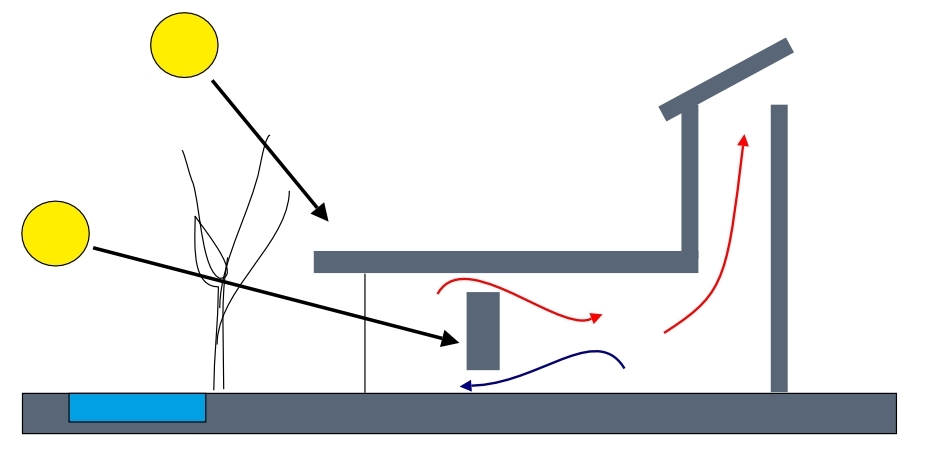Solar shading
Solar radiation can be useful in providing natural light and heat for buildings, reducing the need for artificial lighting or heating. This can reduce energy use and so emissions. However, excessive solar radiation can result in overheating, which may need to be countered with energy-intensive cooling, or can cause glare, a form of visual discomfort experienced when lighting is excessively bright.
Part L of the UK building regulations places restrictions on the amount of glazing that can be used in buildings. See also Approved document o and shading for housing, a design guide.
Solar shading, is a form of solar control that can be used to optimise the amount of solar heat gain and visible light that is admitted into a building. This can have a significant impact on the energy use of a building as well as on the thermal and visual comfort of occupants, protecting against overheating and glare on hot or sunny days. It can also provide privacy.
Solar shading can be fixed or moveable (dynamic).
Fixed solar shading can be provided by:
- Canopies.
- Overhanging eaves or balconies.
- Trees and other vegetation.
- External louvres or brise soleil.
- Light shelves.
- Canopies and awnings.
- Solar control glazing.
Dynamic solar shading can be provided by:
- Internal blinds.
- Curtains.
- Internal or external shutters.
- External roller blinds.
- Other adjustable shading devices that respond to conditions.
Under cloudy conditions, moveable shading can be retracted to allow daylight and useful solar gain to enter the buildings, reducing dependence on electric lighting and heating.
However, The way these systems are controlled can have a significant impact on building energy efficiency and on occupant comfort and wellbeing. Incorrect operation can lead to overheating and glare, or can result in a building being shaded when it does not need to be.
Dynamic solar shading can be operated manually by chords, chains and crank handles, or it can be motorised, either hard wired, battery operated or solar powered. This can make control easier and safer and can allow automation, either by timer or in response to actual conditions.
[edit] Related articles on Designing Buildings Wiki
- Angular selective shading systems.
- Automated blinds.
- Blinds.
- BREEAM Visual comfort Glare control.
- Brise soleil.
- Control of solar shading IP 4 17.
- Daylight lighting systems.
- Exterior shutters.
- Glare.
- Louvre (or louver).
- Retrofitting solar shading.
- Solar gain.
- Solar shading of buildings BR 364.
- Solar thermal panels.
- The daylight factor.
- Thermal comfort.
- Urban heat island effect.
- When hospital buildings aren’t healthy.
- Wind Resistance for External Blinds.
Featured articles and news
Government consultations for the summer of 2025
A year of Labour, past and present consultations on the environment, the built environment, training and tax.
CMA competitiveness probe of major housing developers
100 million affordable housing contributions committed with further consultation published.
Homes England supports Greencore Homes
42 new build affordable sustainable homes in Oxfordshire.
Zero carbon social housing: unlocking brownfield potential
Seven ZEDpod strategies for brownfield housing success.
CIOB report; a blueprint for SDGs and the built environment
Pairing the Sustainable Development Goals with projects.
Types, tests, standards and fires relating to external cladding
Brief descriptions with an extensive list of fires for review.
Latest Build UK Building Safety Regime explainer published
Key elements in one short, now updated document.
UKGBC launch the UK Climate Resilience Roadmap
First guidance of its kind on direct climate impacts for the built environment and how it can adapt.
CLC Health, Safety and Wellbeing Strategy 2025
Launched by the Minister for Industry to look at fatalities on site, improving mental health and other issues.
One of the most impressive Victorian architects. Book review.
Common Assessment Standard now with building safety
New CAS update now includes mandatory building safety questions.
RTPI leader to become new CIOB Chief Executive Officer
Dr Victoria Hills MRTPI, FICE to take over after Caroline Gumble’s departure.
Social and affordable housing, a long term plan for delivery
The “Delivering a Decade of Renewal for Social and Affordable Housing” strategy sets out future path.
A change to adoptive architecture
Effects of global weather warming on architectural detailing, material choice and human interaction.
The proposed publicly owned and backed subsidiary of Homes England, to facilitate new homes.
How big is the problem and what can we do to mitigate the effects?
Overheating guidance and tools for building designers
A number of cool guides to help with the heat.
The UK's Modern Industrial Strategy: A 10 year plan
Previous consultation criticism, current key elements and general support with some persisting reservations.
Building Safety Regulator reforms
New roles, new staff and a new fast track service pave the way for a single construction regulator.

























